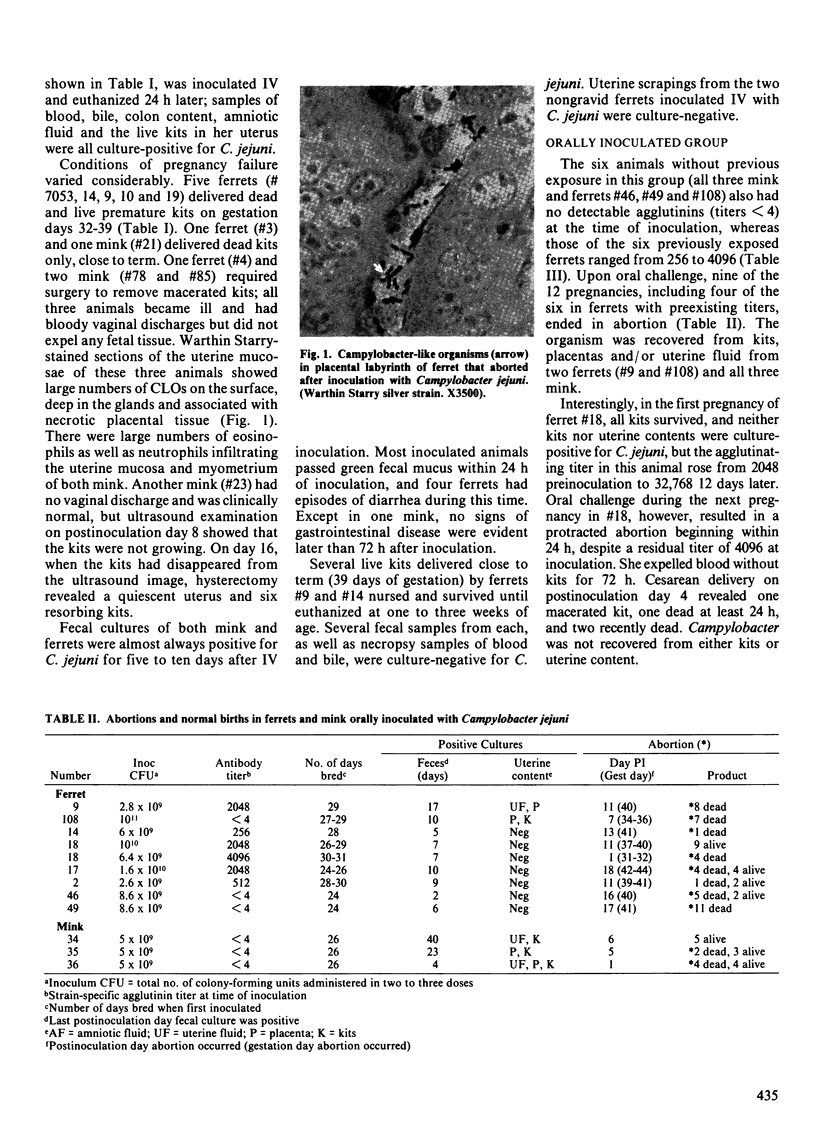Abstract
Four pregnant mink and seven pregnant ferrets, including five with previous exposure and specific antibody, were injected intravenously with 10(8)-10(10) colony-forming units of Campylobacter jejuni. All 11 pregnancies failed 1-16 days after infection, with results ranging from fetal resorption to expulsion of dead or premature living kits. In every case, uterine contents (placenta, uterine fluid and/or kits) were culture-positive for C. jejuni. Three pregnant mink and nine pregnant ferrets, including four with previous exposure and antibody, were fed 10(9)-10(11) C. jejuni. Two of the mink aborted; kits of all three were culture-positive, but those of one female survived. Seven of the nine ferrets aborted, with two having culture-positive uterine contents. None of 28 uninfected ferret control pregnancies ended in abortion. The most prominent histological feature observed was severe placentitis, which appears to be a more likely cause of Campylobacter-induced abortion than direct pathogenic effects on infected kits. These results suggest that infection of mink or ferrets with C. jejuni during pregnancy poses a serious risk of reproductive failure, even for previously exposed females.
Full text
PDF





Images in this article
Selected References
These references are in PubMed. This may not be the complete list of references from this article.
- Al-Mashat R. R., Taylor D. J. Campylobacter spp in enteric lesions in cattle. Vet Rec. 1980 Jul 12;107(2):31–34. doi: 10.1136/vr.107.2.31. [DOI] [PubMed] [Google Scholar]
- Bell J. A., Manning D. D. Prevalence of Campylobacter jejuni in ranch mink at pelting: Cultural, serological, and histological evidence of infection. Can Vet J. 1990 May;31(5):367–371. [PMC free article] [PubMed] [Google Scholar]
- Bruce D., Zochowski W., Fleming G. A. Campylobacter infections in cats and dogs. Vet Rec. 1980 Aug 30;107(9):200–201. doi: 10.1136/vr.107.9.200. [DOI] [PubMed] [Google Scholar]
- Bulgin M. S., Ward A. C., Sriranganathan N., Saras P. Abortion in the dog due to Campylobacter species. Am J Vet Res. 1984 Mar;45(3):555–556. [PubMed] [Google Scholar]
- Coid C. R., Fox H. Short review: campylobacters as placental pathogens. Placenta. 1983 Jul-Sep;4(3):295–305. doi: 10.1016/s0143-4004(83)80009-5. [DOI] [PubMed] [Google Scholar]
- Fox J. G., Ackerman J. I., Newcomer C. E. Ferret as a potential reservoir for human campylobacteriosis. Am J Vet Res. 1983 Jun;44(6):1049–1052. [PubMed] [Google Scholar]
- Fox J. G., Ackerman J. I., Taylor N., Claps M., Murphy J. C. Campylobacter jejuni infection in the ferret: an animal model of human campylobacteriosis. Am J Vet Res. 1987 Jan;48(1):85–90. [PubMed] [Google Scholar]
- Fox J. G., Murphy J. C., Ackerman J. I., Prostak K. S., Gallagher C. A., Rambow V. J. Proliferative colitis in ferrets. Am J Vet Res. 1982 May;43(5):858–864. [PubMed] [Google Scholar]
- Gilbert G. L., Davoren R. A., Cole M. E., Radford N. J. Midtrimester abortion associated with septicaemia caused by Campylobacter jejuni. Med J Aust. 1981 May 30;1(11):585–586. doi: 10.5694/j.1326-5377.1981.tb135843.x. [DOI] [PubMed] [Google Scholar]
- Gough J. F. Campylobacter jejuni: Isolated from an Aborted Caprine Fetus in Ontario. Can Vet J. 1987 Oct;28(10):670–670. [PMC free article] [PubMed] [Google Scholar]
- Hunter D. B., Prescott J. F., Hoover D. M., Hlywka G., Kerr J. A. Campylobacter colitis in ranch mink in Ontario. Can J Vet Res. 1986 Jan;50(1):47–53. [PMC free article] [PubMed] [Google Scholar]
- Hunter D. B., Prescott J. F., Pettit J. R., Snow W. E. Campylobacter jejuni as a Cause of Abortion in Mink. Can Vet J. 1983 Dec;24(12):398–399. [PMC free article] [PubMed] [Google Scholar]
- Hänninen M. L., Ekman T., Saranpä T., Valtonen M. The occurrence of thermophilic Campylobacter in mink and an experimental oral infection of pregnant mink by Campylobacter jejuni. Acta Vet Scand. 1988;29(3-4):463–468. doi: 10.1186/BF03548643. [DOI] [PMC free article] [PubMed] [Google Scholar]
- Osburn B. I., Hoskins R. K. Experimentally induced Vibrio fetus var. intestinalis infection in pregnant cows. Am J Vet Res. 1970 Oct;31(10):1733–1741. [PubMed] [Google Scholar]
- Peter A. T., Bell J. A., Manning D. D., Bosu W. T. Real-time ultrasonographic determination of pregnancy and gestational age in ferrets. Lab Anim Sci. 1990 Jan;40(1):91–92. [PubMed] [Google Scholar]
- Rettig P. J. Campylobacter infections in human beings. J Pediatr. 1979 Jun;94(6):855–864. doi: 10.1016/s0022-3476(79)80202-4. [DOI] [PubMed] [Google Scholar]
- SMITH H., WILLIAMS A. E., PEARCE J. H., KEPPIE J., HARRIS-SMITH P. W., FITZ-GEORGE R. B., WITT K. Foetal erythritol: a cause of the localization of Brucella abortus in bovine contagious abortion. Nature. 1962 Jan 6;193:47–49. doi: 10.1038/193047a0. [DOI] [PubMed] [Google Scholar]
- Smibert R. M. The genus Campylobacter. Annu Rev Microbiol. 1978;32:673–709. doi: 10.1146/annurev.mi.32.100178.003325. [DOI] [PubMed] [Google Scholar]
- Walker R. I., Caldwell M. B., Lee E. C., Guerry P., Trust T. J., Ruiz-Palacios G. M. Pathophysiology of Campylobacter enteritis. Microbiol Rev. 1986 Mar;50(1):81–94. doi: 10.1128/mr.50.1.81-94.1986. [DOI] [PMC free article] [PubMed] [Google Scholar]



